
What is the ketogenic diet?
1992 brought us the Atkins Diet, 1995 brought the Zone, in 2003 the South Beach diet sprung up and now the ketogenic (keto) diet is having its moment. What do all of these diets have in common? They all focus on manipulating (or virtually eliminating) carbohydrates in the diet, as a means to weight loss.
One clear difference between the keto diet and the others listed is that it’s actually a therapeutic diet that has somehow morphed into a fad diet, now growing in popularity.
To give a brief history: the keto diet was first conceptualized in the 1920s as a treatment method for seizure disorders. As production of anti-seizure medications grew in the 1930s-1970s, interest in the diet diminished. From the 1970s-1990s there was renewed interest in the diet as a therapeutic treatment and different variations of it were created, such as the Medium Chain Triglyceride (MCT) version. This is the version that seems to be gaining the most hype today as a method for weight loss. Have you heard of the coconut ketogenic diet? This is another name for the MCT version since coconut oil is a source of MCTs, and a growing fad in its own right.
To understand why the keto diet has gained traction as a method for weight loss, we have to first think about what the diet entails and how it works in the body.
A ketogenic diet is very high in fat, adequate in protein and very low in carbohydrates. Carbohydrates are our body’s main source of energy, so when they are limited in the diet, our body will look for other forms of energy to fill that gap. This is where the fat in the keto diet comes in. Without carbohydrates, our insulin levels drop and fat is released from our cells. The fat that is released overwhelms the liver which turns it into ketones. Ketones are our body’s second choice to carbohydrates as a source of energy. It’s ‘second choice’ because some of our brain cells can only use glucose (or carbohydrates) for energy.
The ketogenic diet appears to mimic starvation by using fat as an alternative fuel source for the body, producing ketones. This is what is referred to as ketosis.
So how do people lose weight on the keto diet? One common theory is that the diet works by depleting glycogen stores. Glycogen, which stores glucose, also stores water. When stores are depleted, we lose excess water, leading to rapid weight loss.
Let’s look at the ketogenic diet practically. What does high fat, moderate protein and low carb look like? The traditional keto diet is approximately 90% fat, 8% protein and 2% carbohydrates. How can a person meet this macronutrient distribution? For a 150 pound woman, with a daily calorie requirement of approximately 1700 calories for weight maintenance, 2% carbohydrates would equal to 34kcal, which would equate to approximately one half of one slice of bread. This means no other grain products, no fruits and no vegetables, besides leafy greens.
There are multiple issues with following such a restrictive diet. You would not only be depriving your body of its preferred source of energy: glucose, but putting yourself at risk for developing micronutrient deficiencies. Deficiencies are common when whole food groups are limited in the diet; in this case fruits, vegetables and grain products are virtually eliminated. Yes, on the keto diet you can load up on meat, fish, cheese, heavy cream, avocados, oils, nuts and low carb green leafy vegetables, but you’d also be loading up on saturated fat and cholesterol, putting yourself at a higher risk for cardiovascular disease.
The bottom line is that any diet which eliminates food groups, promotes an excessive intake of saturated fat and advertises rapid weight loss is one to be wary of. The ketogenic diet is a therapeutic diet, not originally intended for the purpose of promoting weight loss. The diet should only be attempted under the recommendation and monitoring of a registered dietitian in partnership with neurologists and medical doctors. Any diet that requires this type of professional support is not one that should be attempted on a whim.






















